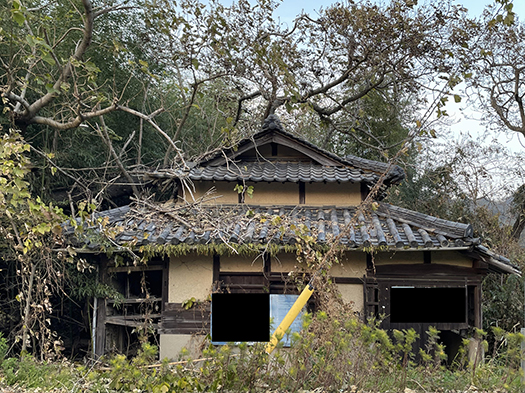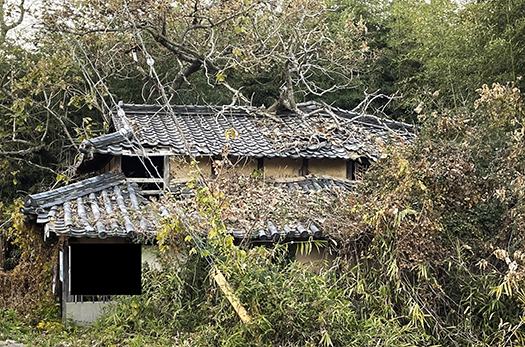

本日は人口減少に伴う「廃屋」についてのエピソードを。住空間を探訪し続けるとだんだんその「終活」にも思いが及んでいって、廃屋についての興味も盛り上がっていく。
いわゆる廃屋の数は調査には反映されない。空き家という調査はされるけれど、その定義は「居住世帯のない住宅」ということで廃屋の概念とは違う。住宅・土地統計調査は人が住める住宅を対象とする統計なので廃屋の空き家を含めると、実際の空き家数は2018年の最新調査846万戸より多くなるとされている。空き家率は13.6%となっている。過去最高のレベルが毎回更新されてきている。
まぁ、こういう廃屋が日本の風景の中で徐々にふつうのワンシーンになってきている。そういうなかでも目立っていたり、グッドルッキングな建物というのもあるでしょう。
兵庫県淡路島で瀬戸内海側から大阪湾側に横断したときに、きわめて印象的な廃屋があって、おもわずシャッターを切りたくなった。なんというのか、訴求してくる美感に色気があるというのでしょうか。見始めると、そのプロポーションも素材感も、まつわりついてくる植物群も、渾然一体となって迫ってくる美しさ。
1枚目の正面写真などバランス的に非常に整合的。角地に立っているので側面からの表情も端正だと思える。さぞかし使われていたときにも、地域の一種のランドマーク的な存在だったに違いない。
きっとそういうことからか外壁面に違う政党たちがなんと選挙ポスターを貼りまくっていた。政治的中立性を保つために(笑)その政党名ポスター部分は黒塗り画像処理しましたが、まぁ商魂たくましい、いや、政治主張の声高ぶりを強く感じてしまう。ふつう住宅に貼られている政党ポスターはその家主が賛同して貼っているものでしょうが、ここでは正反対と思われる政党同士が仲良く(?)主張されていた。この建物がまごうことなき廃屋であることの,ある意味での地域社会の中での証明かもと思われる。廃屋側からすると、住居としてながく利用されなくてもこのように利用されるという一種の誇らしさもあるかも知れない。
こうした廃屋を含めての空き家総数が全住宅数の13%を超えている現実、そして増加傾向はまだまだ進展しそうだというのが日本の実態。さまざまな社会構造要因がそこにはあるのでしょうが、資産管理の適正化という見方からするとやはり残念感はある。現代はこういう新たな現実への対応が求められているようにも思える。
後世の人たちのためにも、政党ポスター展示ばかりではない再生法を考えるべきなのでしょうね。
English version⬇
[Unfortunate political party posters clustered around a beautiful abandoned house.
The national “vacant house rate” is over 13%. It is a sense of disappointment as an asset utilization of the nation as a whole. On the other hand, I think they are a beautiful and decaying form of existence that makes us pull back our hair. …
Today’s episode is about “abandoned houses” due to the declining population. As I continue to explore living spaces, I am gradually becoming more and more interested in the “end of life” of these “abandoned houses”.
The number of so-called abandoned houses is not reflected in the survey. The survey does include vacant houses, but the definition of “vacant house” is different from that of abandoned houses. The Housing and Land Survey is based on housing that can be inhabited, so if abandoned and vacant houses are included, the actual number of vacant houses is estimated to be higher than the 8.46 million units in the latest survey conducted in 2018. The vacancy rate is 13.6%. The record level has been renewed every time.
Well, these abandoned houses are gradually becoming a common scene in the Japanese landscape. Among them, there are some buildings that stand out and are good-looking.
When I crossed from the Seto Inland Sea side to the Osaka Bay side in Awaji Island, Hyogo Prefecture, I saw an extremely impressive abandoned house and felt compelled to snap the shutter. I couldn’t resist snapping my shutter when I saw it. Once you start looking at it, the proportions, the texture of the materials, and the plants that cling to it all come together to form a beautiful whole.
The first picture, the front one, is very consistent in terms of balance. The side view is also very neat as it stands on a corner lot. It must have been a kind of landmark in the area when it was used.
Perhaps that is why different political parties were putting up election posters all over the exterior walls. To maintain political neutrality (laugh), I blacked out the party name posters and processed the image, but I felt that they were very commercial, or rather, very loud in their political assertions. Normally, posters of political parties on houses are put up with the approval of the house owner, but here, political parties, which seem to be opposite to each other, were arguing in good harmony (?). But here, the opposite political parties were in harmony (?). This may be a proof to the local community that this building is indeed an abandoned house. From the side of the abandoned house, there may be a kind of pride in the fact that it is used in this way even if it is not used as a residence for a long time.
The reality is that the total number of vacant houses, including such abandoned houses, exceeds 13% of the total number of houses in Japan, and the increasing trend is likely to continue. There may be various social structural factors at play, but from the viewpoint of proper asset management, it is still disappointing. It seems to me that today we are being asked to respond to these new realities.
For the sake of future generations, we should probably consider a revitalization method that is not all about party poster displays.
Posted on 7月 3rd, 2023 by 三木 奎吾
Filed under: 住宅マーケティング







コメントを投稿
「※誹謗中傷や、悪意のある書き込み、営利目的などのコメントを防ぐために、投稿された全てのコメントは一時的に保留されますのでご了承ください。」
You must be logged in to post a comment.